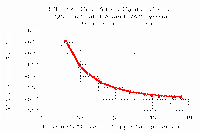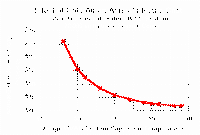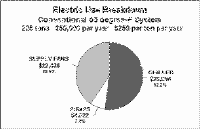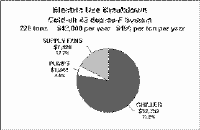HVAC Cold Air
Distribution
INTRODUCTION
HVAC Cold Air Distribution is an
air-conditioning system type that yields greater cooling performance for a lower
cost than conventional systems. Both equipment costs and energy costs are less
for cold air systems. Humidity levels can be lower with cold air systems,
resulting in improved air quality, comfort and productivity. The physical size
of HVAC equipment is smaller, resulting in smaller mechanical rooms, less dead
space above ceilings, and more room for occupants. Capital savings can pay for a
thermal storage system, which will further reduce energy costs.
Cold air systems can do more for
less. Nonetheless, HVAC designs based on cold air distribution are not as
forgiving, so more attention to details is required in the design phase. This
includes designing to prevent condensation on the cold surfaces of system
components, and careful selection of ceiling diffusers to ensure adequate mixing
of cold air with room air. Duct leakage is more of a concern than with
conventional systems, and coil selection is based on parameters that are
different from conventional designs. In short, cold air systems demand more from
the designer and approach the limits of component capabilities. When properly
applied, the benefits are lower capital costs, lower energy costs, and less
humidity.
BACKGROUND
Cold air systems distribute air
at a temperature of less than 50°F. This is lower than conventional designs,
which distribute air at temperatures of 50-60°F, usually 55°F ±2°F. The
conventional 55°F standard evolved from a need to prevent condensation on
uninsulated duct components and diffusers, and from the desire to maximize coil
temperatures in the days when chillers and compressors were far less efficient
than current equipment. Over many years, it has become a standard design
parameter upon which equipment selection specifications, streamlined design
procedures, and rules-of-thumb are based.
The technology used by the HVAC
industry is becoming more advanced. Three key developments are making cold air
distribution the best option for many buildings: First, the efficiency of
today’s best chillers and compressors is double those of 20 years ago. This
means that reduced system temperatures no longer result in an overwhelming
increase in energy use. It also means that fans and pumps are now a larger ‘pie
slice’ of air-conditioning system energy use -- cold air systems use less energy
because they require far less air and fluid flow than conventional systems.
Second, the importance of air quality has become paramount. Larger quantities of
outside air are being used. In humid climates this has resulted in excessive
indoor humidity and fungal growth in many buildings. Cold air systems can be
designed to control humidity without the expense of special equipment or the
additional energy use of active dehumidification. Finally, computer advances
have resulted in precise digital controls, and more accurate system design
tools. These are needed because cold air systems are not as forgiving.
CASE STUDY: HEALTH SCIENCE
CENTER
As an example, consider the
application of Cold Air Distribution to a 72,000 square foot Health Science
Center under construction on a Florida college campus. The HVAC system is based
around a 225-ton rotary, water-cooled chiller (nominal 0.65 kW/Ton) and three
central-station air-handling units. The building requires 14,650 CFM of outdoor
air.
Capital Costs
Equipment costs for a carefully
designed cold air system will be less for this application. Since the air is
colder, more cooling can be provided per CFM (cubic feet per minute) so less
airflow is needed. This means that air handlers, fans, ducts and chilled water
pumps are smaller and less costly, and that they take up less space.
|
TABLE 1: EQUIPMENT COST
COMPARISON |
| |
55°F system |
42°F system |
|
Air Handling Units |
$ 122,760 |
$ 70,580 |
|
Ductwork |
126,540 |
109,500 |
|
Pumps |
5,875 |
4,150 |
| Chiller and Tower |
123,980 |
123,980 |
|
Controls and Other |
119,285 |
136,429 |
|
TOTAL |
$ 498,440 |
$ 444,639 |
|
Percent Saved |
|
10.8% |
|
Amount Saved |
|
$ 53,801 |
 In
theory, the colder the design air temperature, the less airflow is needed and
the lower the capital costs, as shown in the chart. The coldest practical air
temperature is about 38°F, with most cold air designs using 42-48°F. Lower
temperatures are possible in special designs that deal with chilled water
temperatures approaching the freezing point, the limitations of currently
available coils designed for 55°F operation, and more critical duct leakage and
condensation concerns. For the Health Science Center, a comparison was made
between a conventional 55°F system and a 42°F cold air distribution system. As
summarized in Table 1, the cold air distribution system provides an 11% savings
on equipment costs. Costs for the air handling units, ductwork, pumps and piping
are reduced by $70,945. Increased controls complexity, diffusers, and more
detailed engineering added $17,144 for a net savings of $53,801.
In
theory, the colder the design air temperature, the less airflow is needed and
the lower the capital costs, as shown in the chart. The coldest practical air
temperature is about 38°F, with most cold air designs using 42-48°F. Lower
temperatures are possible in special designs that deal with chilled water
temperatures approaching the freezing point, the limitations of currently
available coils designed for 55°F operation, and more critical duct leakage and
condensation concerns. For the Health Science Center, a comparison was made
between a conventional 55°F system and a 42°F cold air distribution system. As
summarized in Table 1, the cold air distribution system provides an 11% savings
on equipment costs. Costs for the air handling units, ductwork, pumps and piping
are reduced by $70,945. Increased controls complexity, diffusers, and more
detailed engineering added $17,144 for a net savings of $53,801.
Energy Costs
Electric use by the smaller air
handler fans and chilled water pumps of the 42°F design will be less. This
savings more than offsets the small increase in chiller electric use due to the
colder water temperature. As shown in the chart below, minimum cost is achieved
at around 42°F supply air temperature. . (The minimum cost for other buildings
may be at a different
 temperature.)
Compared with a 55°F system, annual fan electric costs are $15,000 less, and
pump electric costs are reduced by $2,180. Chiller electric costs increase by
just $3,750, giving a predicted net savings of $13,485 per year, a 24% savings
compared with a 55°F system.
temperature.)
Compared with a 55°F system, annual fan electric costs are $15,000 less, and
pump electric costs are reduced by $2,180. Chiller electric costs increase by
just $3,750, giving a predicted net savings of $13,485 per year, a 24% savings
compared with a 55°F system.
The 55°F design option included
fan terminal units with reheat coils. Some amount of reheat would have been
called for to keep humidity below 60% rh with the 55°F system. Since reheat is
not a part of the cold air design, reheat savings could be as much as $6,000 per
year additional. Total capital plus energy life-cycle (20-years) savings will be
at least $340,000, or $4.70 per square foot with the cold air system. So not
only is the cold air system less expensive to install, it also costs less to
operate.
HUMIDITY CONTROL
 Larger
quantities of outside air are being used in HVAC system designs to improve air
quality and to comply with ASHRAE Standard 62-1989. In humid climates, increases
in outside airflow have resulted in excessive indoor humidity and fungal growth
in many buildings. Cold air distribution systems can be designed to control
humidity without the expense of special equipment or the additional energy use
of active dehumidification
Larger
quantities of outside air are being used in HVAC system designs to improve air
quality and to comply with ASHRAE Standard 62-1989. In humid climates, increases
in outside airflow have resulted in excessive indoor humidity and fungal growth
in many buildings. Cold air distribution systems can be designed to control
humidity without the expense of special equipment or the additional energy use
of active dehumidification
 Cold
air systems are better able to maintain indoor relative humidity below 60% rh,
even with outside air flow rates approaching 70% of the supply air flow. With
any system, space relative humidity increases as the fraction of outside air
increases (as it can by design and/or during the normal operation of variable
air volume (VAV) systems). Nevertheless, the humidity with cold air distribution
is always less.
Cold
air systems are better able to maintain indoor relative humidity below 60% rh,
even with outside air flow rates approaching 70% of the supply air flow. With
any system, space relative humidity increases as the fraction of outside air
increases (as it can by design and/or during the normal operation of variable
air volume (VAV) systems). Nevertheless, the humidity with cold air distribution
is always less.
Relative humidity will probably
exceed the ASHRAE recommended maximum of 60% rh when outside air fraction
exceeds 20% with conventional 55°F systems. Furthermore, humidity usually
increases at part load conditions, for example, in the morning and evening when
the temperature is in the mid 70’s to low 80’s. Properly optimized cold air
systems can keep humidity below 60% rh, even with large fractions of outside air
at part load conditions, and in many cases without the use of costly reheat.
Close This Window
 In
theory, the colder the design air temperature, the less airflow is needed and
the lower the capital costs, as shown in the chart. The coldest practical air
temperature is about 38°F, with most cold air designs using 42-48°F. Lower
temperatures are possible in special designs that deal with chilled water
temperatures approaching the freezing point, the limitations of currently
available coils designed for 55°F operation, and more critical duct leakage and
condensation concerns. For the Health Science Center, a comparison was made
between a conventional 55°F system and a 42°F cold air distribution system. As
summarized in Table 1, the cold air distribution system provides an 11% savings
on equipment costs. Costs for the air handling units, ductwork, pumps and piping
are reduced by $70,945. Increased controls complexity, diffusers, and more
detailed engineering added $17,144 for a net savings of $53,801.
In
theory, the colder the design air temperature, the less airflow is needed and
the lower the capital costs, as shown in the chart. The coldest practical air
temperature is about 38°F, with most cold air designs using 42-48°F. Lower
temperatures are possible in special designs that deal with chilled water
temperatures approaching the freezing point, the limitations of currently
available coils designed for 55°F operation, and more critical duct leakage and
condensation concerns. For the Health Science Center, a comparison was made
between a conventional 55°F system and a 42°F cold air distribution system. As
summarized in Table 1, the cold air distribution system provides an 11% savings
on equipment costs. Costs for the air handling units, ductwork, pumps and piping
are reduced by $70,945. Increased controls complexity, diffusers, and more
detailed engineering added $17,144 for a net savings of $53,801.


